What could a residency for an interdisciplinary artist look like?
- natashahyman
- Feb 7, 2019
- 10 min read
Updated: Feb 8, 2019

For the first What If? interview I met with performance maker Emma Noelle Clark to talk about interdisciplinary theatre-making, artistic homes, alternative forms of authorship, and making theatre in Parliament.
Emma Clark is a California-born theatre maker currently based in East London. She is currently developing devised performance projects including Atlantic and One Shot with PJ Stanley, Monumental with Tacky Pioneer, the solo project Gold Mountain, and the accident did not take place with YESYESNONO. Emma is the lead artist of the The Yard Theatre's Yardlings: Bigger programme for young people ages 7-11 in Hackney Wick for the 2018/19 school year, and trained on the Master's in Advanced Theatre Practice at Central.
This interview is condensed from a longer conversation.
T Perhaps a good place to start is for you to describe your process?
E There are some people who devise who start from plays, but my practice is generating original performance material out of sources that might be from other disciplines entirely.
T Can you give some examples of sources you've used in the past?
E I am interested in embodied or anthropological research processes. I have to go and learn or do a thing that's not at all related to art or theatre. So, last year I did this project on astronaut training and a lot of that was looking into science and real-life physical training processes that scientists might go through.

T So it’s quite practical in that sense. You want to immerse yourself in that way of life?
E Yes, there's an ambition towards immersion but the research doesn't always look like that because it's not always possible. So, for example, this project about astronauts, I think there was absolutely an ambition there to have access to astronauts. I think if you have the profile and the partners then maybe you can be embedded somewhere like that.
As much as possible I am gathering experiences and putting my body in real experiences - being outside of the rehearsal room, to gather inspiration, material, research. A rehearsal for this astronaut project included being at a pool for the day, to explore weightlessness in water.
T So that's a useful starting point to think about what a residency might look like. When we think about a residency we are talking about a period of time, when you're on attachment physically to a building or a place.
E For this thought experiment I'd like to think about a longer time period, maybe a year or 18 months.
T So it's like an associate role?
E Yeah. There are a lot of residency offers for one or two weeks with open applications. But what we're talking about here is a much longer engagement within the organisation.
It does feel like there are models for this kind of thing with writers - they're within a building writing a play.
T Yes, there’s a writers’ room where they are working and occasionally the literary manager to chat to them. They're part of the building, but quite isolated.
E Yes but their working practice is maybe more isolated than other roles. If you're on attachment as an a director, you've probably got a pretty clearly understood job, you're assisting, or dramaturging or directing. This is more akin to having a writer on attachment but with a different set of needs. It does strike me that you can be on attachment for a short time at the NT studio with a project, but those are project specific. Or if there are longer ones I don't know anyone on them!
T So ok then, let's spitball your What if? Hopes and dreams, no budget, what do you want?
E A glitter cannon..! Ha. I was thinking this morning about how part of it is a desire to have some kind of artistic home. A set of people have taken a look at the work you're doing, your ambitions and said we want to invest in that - to cultivate the development of that person.

T What does having an artistic home give you?
E If it comes with economic remuneration, that relieves some of the day to day strain of trying to survive. My practice involves a full-bodied engagement from me and I'm often in the work I'm making, so I have felt burnt out. When I am under-resourced in terms of energy, emotion, and finances - there's no way to have a sustainable working practice. Having a salary and a place to go - a workplace, also means you can say ‘this is my work-place, this is my job, and it's a valid job to have.’
The other ambition with my practice is that it can be responsive and rapid - it can shift and move and show up formally as all kinds of things. I want to be creating stuff beyond the stage - be that an installation or an intervention in space in some way. I'd love for that to be a daily pursuit and not just project-based.
T So are you gaining inspiration from this home that you're in?
E Yes, ideally. For me personally, it would be great to say: these are a set of projects and tangible ideas I’m cooking on. It would be great to have space for them to breathe and for me to think on them and allow them to grow and potentially be made. I also feel it would be really important to be responding to and involved in the working life and culture of that building. The Royal Court have been experimenting with this, they had a designer in residence. That strikes me as a model in which they're supporting someone to do their work, but also it's interjecting within the life of that building.
T There's so much for you to gain, but they can also gain from you being there. With a writer on attachment - they know they're receiving the play. From you, they're getting something more organic, varied, drip-fed, not just one thing at the end but we might be looking at a model more akin to the Chloe Lamford The Site project at The Court. That’s something they might not have imagined until Chloe connected with them...
E Exactly. Also Tom Scutt directing at the Donmar - that’s inspiring. They are thinking of ways of disrupting or provoking the building. I guess the difficulty with a contemporary performance practitioner is that the products given - if you want to put it that way - are much less tangible. I can't claim to offer you all these scenic ideas, I can't promise you a finished playtext. It's not as quantifiable. It's difficult to consider how to support and resource this kind of work because often people don’t know what it looks like or understand it until it's done. And then when it's been made, all the risk and strain of making it has already fallen on the maker.
T In terms of resources, what would you want?

E Having access to basic tech on an ongoing basis for experimentation would be great. One thing that my collaborator PJ said to me once, was that it would just be nice to walk into a room and know that I had more to work with materially than just tin foil, a couple of bits of paper and some markers. It would be nice to devise with more than that, even though we know we can devise with just that.
It strikes me that I'm fighting this constant impulse to qualify with the fact that, because I devise, I could make out of nothing. And anyone can. That's true. I can rehearse in my living room. And I can scale my ideas to the resources that I have. But what we're talking about is an ideal setting. And that is outside of my home. More and more I'm feeling it's important that for my mental health, that my home is not my work. It's not conducive to viewing work as work, being in a space where you could also throw yourself in your bed because it's two feet away. If you're ever struggling with the work, if it ever gets tense or heated - it's weird to be doing that in your home space.

T And you need those moments where it gets tricky and hard...
E Yes. And it's hard to bring that negative or just charged energy, which is absolutely natural, into your home space. Because then it feels personal in a way that it shouldn't have to be and isn't useful.
T So talk to me about this idea of a residency in somewhere that isn’t in a theatre?
E I'm hugely keen on that notion. It relates back to what I was talking about feeling like my practice is concerned with a direct engagement with the world outside of the arts. It can often feel like you're creating work within a vacuum. Being in a non-arts space in residence would both expose that space to art-making, as well as expose the art-making to the stuff of the world outside of the studio.
The intention would be to work on practice - using the environment as the source and finding ways in which your presence would provoke the space in some way, to generate dialogue.
T What kind of spaces are we talking about?
E Local government, somewhere bureaucratic or civic - that's been on my mind. Put a deviser in residence at The Parliament! Noticing, observing, making things in response, generating things in the space that shake it up, comment on it...
T And also, being on attachment to a theatre might enable you to connect with non-artist experts to make work?
E Yeah! Whilst it's not about validation, having a partner on board gives you a certain kind of legitimacy. You can do that independently but people can be a bit wary when there's no other person attached to the project. From their point of view, what are you going to do with that sensitive material? It might seem a bit exploitative. It does help to have that partner on board and a place I can invite people to. Rather than asking, can we meet in a coffee shop? When there's no-one else behind the long-term life of the project, the terms of that engagement aren’t clear.
T Is it also about demystifying theatre practice?
E Exactly. I do think that part of it is that so much of the means of production of theatre are just walled off to people's eyes. I know some theatres have open rehearsal policies but that's rare.
T Or the glass wall at the National?
E - over the set studio. Which I thought was a simple and lovely idea. Theatre can be so divorced from the stuff of life and the cities in which we're making it; it becomes mystical and obscure. There's a reason none of our parents can understand what we're doing...
T With this residency idea I guess we are also challenging a notion that a practice can be found, and instead suggesting that practice is always evolving and changing.
E And why is it that the only place to do that seems to be in a school environment?
I have a director friend, and she feels the only space she can experiment and take risks and try some things formally is when she’s directing in drama schools. In the professional context she feels there could be some backlash - maybe she wouldn't be invited back and there would be a career risk. But in a drama school everyone is learning so she feels she has permission to learn. I think the idea behind an attachment is that it is concerned with expanding craft. There's this massive gap when trying to work on practice outside of school. There aren't really assistant maker roles or opportunities to be in someone else's room. I'm sure there are people doing that on an informal basis off their own backs. I have popped into the rooms of my peers, but if that's always unpaid and taking time away from survival work, it's a strain.
T This residency is about a space to change?
E That's a really good way of putting it.
Maybe this project needs this completely different approach, and how do we go about making that change without resourced time and space.
T What about if a building makes writer-led plays, why is it in their interest to have a theatre maker on board?
E I understand the value of having a specific mission statement and to not have every venue be multi arts. On the other hand, I find there to be something interesting about juxtaposing the practice of the building. What would that do to the kind of work that's programmed? Let's just bust it open!

I've seen tangible shifts happening, for example, I think the The Bush's whole season announcement was about 'what a writer looks like' and that included a company in the announcement.' This extended time period within an arts organisation makes these other forms of practice more visible and legible, while also helping the artist to better understand what they do. It can be mutually supportive.
Part of my brain is saying there are some schemes that look like this, so this isn't necessarily thinking around a new idea but I think there is something underlying about a cultural shift in terms of the way we think about supporting certain kinds of practices.
T There is this whole narrative of risk around this type of work...
E And what is the definition of whether something works or not?
If I could slightly alter this thought to: 'It strikes me that this narrative of risk for certain kinds of work, whether it be made through non-traditional working practices, or by perspectives that are often marginalised, that narrative of risk, to make the choice not to programme and not to give resource to, and to silence, or to shoehorn into certain smaller spaces...beyond the financial narrative of 'what will sell', it seems predicated on the idea that there is an objective good play or good piece of work.
There’s this idea that devised work is less rigorous somehow because it's not been vetted through this writing or structuring process that looks like what plays look like and I find that frustrating. Because for me, devisers bring an extremely keen, intuitive sense of dramaturgy and open up the possibility of thinking about other non-traditional dramaturgies, not masculine or western ones...
T Not text based ones...
E There's an openness in that you can't submit and evaluate based on a script - but who is to say that if you were to trust the making process of that group of artists that the product wouldn't be great.
T We are a capitalist society that is product-orientated but our work doesn't have to be like that. There are artists whose work changes every time it is performed.
E Absolutely. My head hurts now…
T Me too.

The Lead Up
Below is the email dialogue that led up to this interview. It includes the avenues we didn't go down, the development of the ideas we explore here.


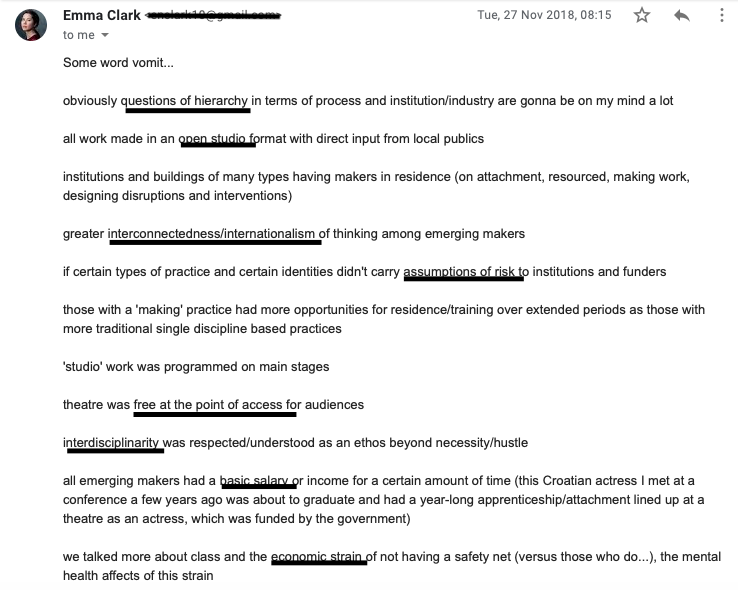

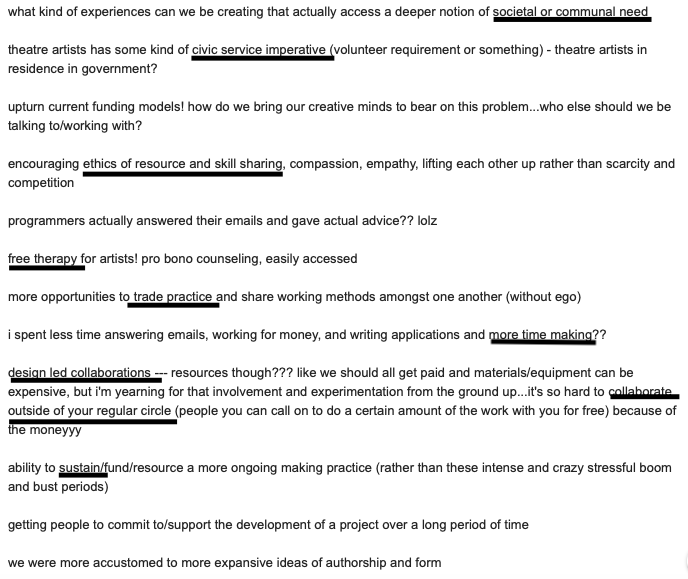

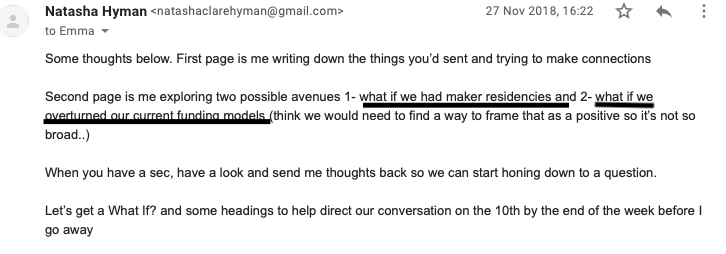

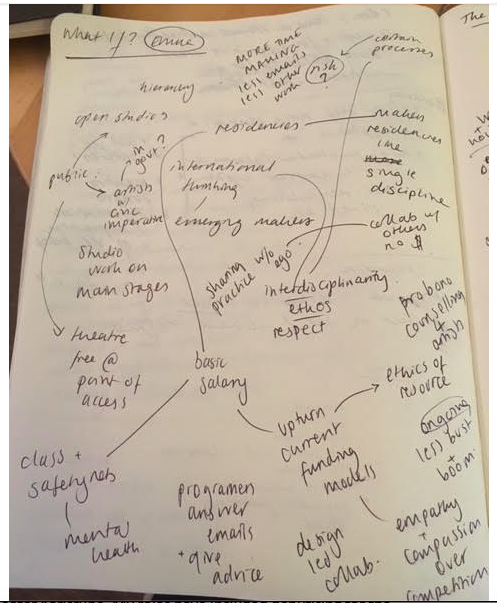

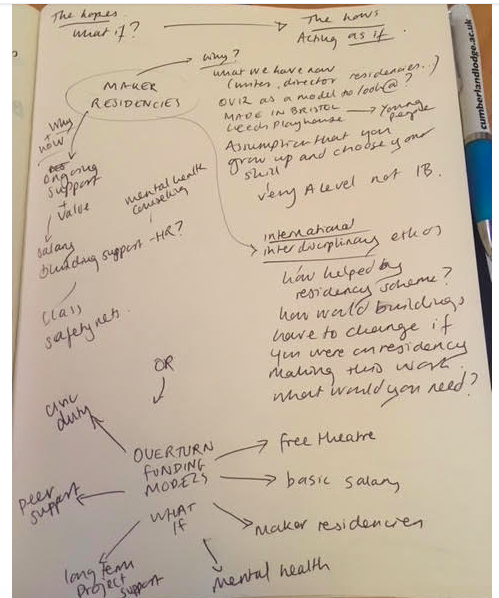



Comments